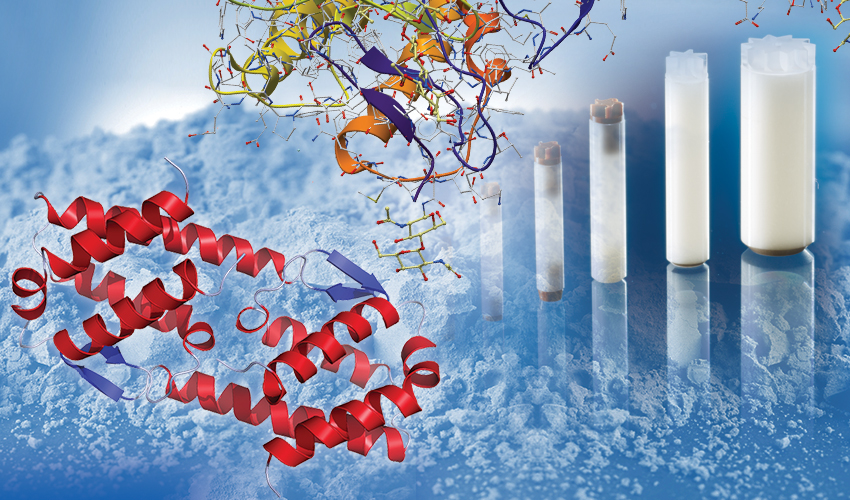

NMR Spectroscopy for Solids
A rapidly growing body of techniques to study solid materials using nuclear magnetic resonance (NMR) spectroscopy is providing unique views into the structure, kinetics, and dynamics of inorganic and biological molecules. Materials scientists use solid-state NMR to examine crystalline, amorphous, and composite materials, as well as suspensions and mixed samples with liquid or gas components.
Applications range from research into surface electrochemistry in fuel cells to structural determination of crystalline powders and studies of molecular structures in crude oil fractions. In structural biology, solid-state NMR allows insights that aren’t possible with X-ray crystallography and liquid-state NMR, by enabling detailed study of materials in situ – for example, proteins embedded in biological membranes or amyloid fibrils in Alzheimer’s plaques.
As in NMR for liquids, solid-state NMR spectroscopy probes molecular makeup and structure by capturing subtle changes in the magnetic behavior of specific atomic nuclei resulting from interactions with nearby electrons and atoms. Most of these interactions are anisotropic – that is, dependent on the orientation of a molecule relative to the baseline magnetic field. In liquids, Brownian motion averages anisotropic effects to zero, producing high-resolution NMR spectra. As molecular mobility declines in gels, crystals and other solid materials, spectral lines broaden and resolution drops. Specialized solid-state NMR techniques manage and even take advantage of this anisotropy.
Magic Angle Spinning
Many solid-state NMR techniques mimic the free tumbling of molecules in liquids by spinning the sample during data acquisition. Spinning rapidly enough at a specific angle to the baseline magnetic field – the magic angle – can narrow spectral lines, boosting resolution. Magic-angle spinning (MAS) averages anisotropy in nuclear dipole interactions to zero, and chemical shift anisotropy to a non-zero value. (See NMR for Liquids to read about nuclear coupling and chemical shift, and the electron and nuclear interactions they reveal.) Additional manipulations, such as spinning on multiple axes or adding a polarizing energy, can help to address anisotropy in interactions of quadrupolar nuclei (those with spin greater than one half) and other elements.
Many MAS applications can match the resolution of liquid-state NMR. In general, faster spinning produces higher resolution, with new ultra-fast spinning NMR probes pushing the limits.
Learn practical aspects of performing MAS this Video Tutorial: How to Fill MAS Rotors for Solid State NMR.
Spin Decoupling and Recoupling
Often combined with MAS, high-power pulses of radio-frequency (RF) energy can improve resolution through an effect called spin decoupling. As noted for liquid-state NMR, adjacent nuclei influence each other’s magnetic environment through the effects of their angular momentum and magnetic moments – their spins. For example, hydrogen atoms joined by a covalent bond experience this spin–spin coupling through their bond.
Nuclei most often targeted by NMR, such as protons, have a spin of either ½ or -½. By exposing the sample to just the right pulses of RF energy, an NMR experiment can cause specific types of nuclei to flip spin values rapidly enough between the two states that they exhibit an average spin of zero. This nullifies any spin coupling they would normally show. In other words, it decouples the nuclear spins.
In liquid NMR data, nuclear spin coupling causes a single spectral line to multiply in characteristic ways, providing useful information. In solid-state NMR experiments, band broadening due to anisotropic interactions can blur these multiplets into single, wide peaks. Spin decoupling removes the multiplets and narrows the peaks for higher-resolution results. The decoupled nuclei may be of the same element – homonuclear decoupling – or different elements – heteronuclear decoupling. The latter is important in 13C NMR experiments.
The line broadening caused by spin coupling can also provide useful information. Spin coupling is distance dependent. Spin recoupling experiments are used to calculate inter-atomic distances in solid materials, for example, crystal lattices.
Solid-state NMR Experiments
As in liquid NMR, each type of solid-state NMR experiment uses one or more characteristic pulse sequences to probe specific information. Multi-dimensional experiments use multiple pulse sequences to study different nuclei, or the same nuclei under differing conditions. Correlations among the dimensions identify individual atoms within molecules and provide additional information, such as their proximity to each other.
See NMR Spectroscopy for Liquids to read about basic NMR pulse sequences, and NMR 101 for a general outline of a simple, one-dimensional liquid NMR experiment.
Historically, experimental setup for solid-state NMR required an expert to hand-calculate spinning speed and radio-frequency powers for the target nuclei. Today’s NMR operating software automatically calculates the necessary parameters for the spectrometer, RF probe, and research sample, and guides setup of any basic NMR experimental protocol. Instrument stability, resolution and flexibility have also improved, with the development of higher magnetic fields, smaller rotor sizes for faster MAS, and advanced pulse sequences for sophisticated experiments.
Examples of solid-state NMR experiments include:
- standard backbone assignment to elucidate protein structure
- dipolar recoupling to calculate interatomic distances in a crystal structure
- multinuclear, multi-dimensional NMR studies in structural biology, for example, structural and functional characterization of large, rigid proteins and those with paramagnetic centers in solid phase
- advanced methods to study quadrupolar nuclei
- methods using alternate nuclei and dynamic nuclear polarization to study molecular structure of pharmaceuticals


